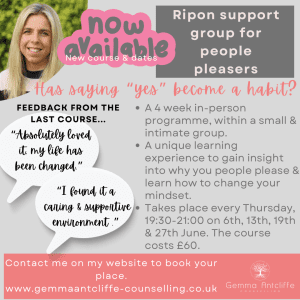I recently ran a small in-person support group for people who identify as “People Pleasers”.
Together we explored what lies beneath people pleasing behaviours, through group discussion and the sharing of experiences. As is the case with these types of therapeutic groups, the insights gained were incredibly powerful and brought about real change.
And I gained some powerful insights of my own.
Lesson 1: My name is Gemma Antcliffe, and I am a “People Pleaser”!
Stick to what you know
We are all familiar with this adage and this was the starting point for the course. For anyone who knows me, I am sure they were somewhat bemused to see me running this course because I am the epitome of a people pleaser.
As therapists, we are wary of touching topics which could pull us in on a personal level. It’s a fear of muddying the waters, finding yourself unable to separate out what belongs to you and what belongs to the client. As I am sure you can imagine, this can lead down a pretty dangerous path.
Yet my experience means I not only understand this set of behaviours from a theoretical perspective, but I also understand it as a human being who is often pulled to put the needs of others above my own.
Lesson 2: Be brave and take imperfect action.
There is no such thing as perfect
I like to imagine a gold thread of perfectionism which runs throughout most people pleasers. This comes from a fear that you might be perceived as not “good enough” by others and you will be rejected.
Much like obsessively checking the long-range weather forecast before an upcoming event, I had been waiting for the “perfect” conditions before doing this course. A quiet couple of weeks where I could sit down and plan all the sessions, a detailed marketing plan to get the course launched…the list went on. I am sure it will come as no surprise to hear, I never got those “perfect” conditions.
Instead, I decided to act, even if it wasn’t perfect and just get it out there. After weeks of procrastination within 2 days I had designed a poster, written a blurb, put the information on my website and splashed it across my social media. There was no backing out now!
I won’t claim this approach was completely stress free and there were moments where I wished I had “more time”. But don’t you think that is a misnomer? Do we ever have enough time?
Lesson 3: Gaining insight is truly empowering.
Ok, so this isn’t something I didn’t know before, but I can confidently say everyone on the course saw something about themselves they had not seen before. And they left feeling more in control.
During the first session we explored how messages in our past can lead to people pleasing behaviours. The notion that rules, comments, and expectations imposed by those responsible for our care are “swallowed whole” and have the power to stay with us for our entire lives.
Yet since these “standards” belong to others from our past and they do not fit with the person we are in the here and now. This creates a conflict, leaving us feeling unhappy, unfulfilled, lost, and/or that we are just not good enough.
I am always careful to point out this is not about parent bashing. Instead, it is an exercise to bring things into the light. If we cannot see something, we are unable to make decisions about what we chose to hold onto it.
Lesson 4: A good therapist avoids the “Helicopter parent” trap.
In my training I was taught early on to “never kick up more dust than you can settle”. Yet when you help shine a light on an issue, there is invariably a feeling that things have been kicked up. When this happens, it can be tempting to “rescue” the client from their anguish, much like a helicopter parent.
It’s fair to say the second week of the course was an emotional one. Gaining insight from week one had been unsettling for the attendees. I got a real sense they felt relief to have answers. Yet there was also anger and upset about the imprint people and events had had upon their lives.
It is natural for therapists to worry about clients outside of sessions and after the second week, I must admit I was a bit concerned. Yet I worked hard to stay grounded in the trust that the attendees had the strength, capacity, and resilience to work through what might feel difficult without me needing to hold their hand.
Nothing could have prepared me for the third week when we re-convened. I saw people in front of me who had all made real and significant changes. I am not over egging it when I say they looked different; something had shifted, and they had done it off their own backs.
Lesson 5: I saw first hand how people pleasing impacts on mental health.
Anxiety and depression is linked to people pleasing.
People pleasing behaviours such as saying “yes” to every request, avoiding conflict and ignoring your true feelings has a serious impact on our mental health. In fact, evidence shows people pleasers experience higher levels of anxiety and depression.
I asked all attendees on the course to complete a pre and post course questionnaires which included tools to measure anxiety and depression. And guess what? Not only did the attendees report a reduction in people pleasing behaviour, their levels of anxiety and depression fell too.
I honestly could not have been prouder or in more awe of the wonderful people who attended my course. They embraced everything I offered and flourished as a result.
If you are reading this and are interested to know more about my people pleasing course and how it can help you, please do reach out. I have a course running throughout June. You can contact me on my website www.gemmaantcliffe-counselling.co.uk.



